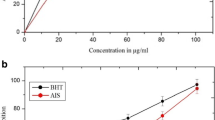Abstract
Elaeagnus umbellata is a plant that grows in the hilly areas of Pakistan. Free radical scavenging activities and anti-lipid peroxidative properties of hot water, methanol, n-hexane, and acetone extracts of E. umbellata berries were evaluated. Extracts showed inhibition against thiobarbituric acid reactive species (TBARS) induced using the pro-oxidants iron (10 μM FeSO4) and sodium nitroprusside (5 μM) in brain and liver homogenates of mice. Extracts also showed metal chelating activities of IC50 (extract concentration that causes 50% scavenging)=40–43 μg/mL and DPPH radical scavenging activities of IC50=45.4–49 μg/mL. HPLC analysis revealed the presence of gallic, vanillic, coumaric, ferulic, sinapic, and caffeic acids in berries. The fruit of E. umbellata is a potential source of antioxidants with therapeutic importance.
Similar content being viewed by others
References
Halliwell B, Gutteridge JMC, Cross CE. Free radicals, antioxidants and human disease: Where are we now? J. Lab. Clin. Med. 119: 598–620 (1992)
Halliwell B. Free radicals, antioxidants and human disease, curiosity, cause, or consequence? Lancet 344: 721–724 (1994)
Hertog MGL, Hollman PCH, Van de Putte B. Content of potentially anticarcinogenic flavonoids of tea infusions, wines, and fruit juice. J. Agr. Food Chem. 41: 1242–1246 (1993)
Dirr MA. Manual of woody landscape plants. Their identification, ornamental characteristics, culture, propagation, and uses. Stipes, Champaign, IL, USA. p. 1325 (1998)
Ahmad SD, Sabir SM, Saud HM, Salihuddin Y. Evolutionary relationship and divergence based on SDS-PAGE of Elaeagnus umbellata (Thunb.) populations a multipurpose plant from Himalaya. Turk. J. Biol. 32: 31–35 (2008)
Eckardt E, Sather A. The nature conservancy element stewardship abstract for E. umbellata practice. Prelim. Report. 111. Dept. of Conservation, VA, USA. pp. 1–4 (1987)
Matthews V. The New Plantsman. Royal Horticultural Society, London, UK. p. 68 (1994)
Ahmad SD, Sabir SM, Zubair M. Ecotype diversity in autumn olive (Elaeagnus umbellata) a plant with multiple micronutrient genes. Chem. Ecol. 6: 509–521 (2006)
Kohlmeier L, Kark JD, Gomez-Garcia E, Martin BC, Steck SE, Kardinaal AF, Ringstad J, Thamm M, Masaev V, Riemersma R, Martin-Moreno JM, Huttunen JK, Kok FJ. Lycopene and myocardial infarction risk in the EURAMIC study. Am. J. Epidemiol. 146: 618–626 (1997)
Fodham IM, Clevidenc BA, Wiley ER, Zimmerman RH. Fruit of autumn olive: A rich source of lycopene. HortScience 36: 1136–1137 (2001)
Khattak KF. Free radical scavenging activity, phytochemical composition, and nutrient analysis of Elaeagnus umbellata berry. J. Med. Plants Res. 6: 5196–5203 (2012)
Ohkawa H, Ohishi N, Yagi K. Assay for lipid peroxides in animal tissues by thiobarbituric acid reaction. Anal. Biochem. 95: 351–358 (1997)
Hatano T, Kagawa H, Yasuhara T, Okuda T. Two new flavonoids and other constituents in licorice root: Their relative astringency and radical scavenging effects. Chem. Pharm. Bull. 36: 2090–2097 (1998)
Puntel RL, Nogueira CW, Rocha JBT. Krebs cycle intermediates modulate thiobarbituric acid reactive species (TBARS) production in rat brain in vitro. Neurochem. Res. 30: 225–235 (2005)
Singleton VL, Orthofer R, Lamuela-Raventos RM. Analysis of total phenols and other oxidation substrates and antioxidants by means of Folin-Ciocalteu reagent. Method. Enzymol. 299: 152–178 (1999)
Kosalec I, Bakmaz M, Pepeliniak S, Vladimir-Knezevic S. Quantitative analysis of the flavonoids in raw propolis from northern Croatia. Acta Pharmaceut. 54: 65–72 (2004)
Ghazanfari G, Minaie B, Yasa N, Nakhai LA, Mohammadirad A, Nikfar S, Dehghan G, Boushehri VS, Jamshidi H, Khorasani R, Salehnia A, Abdollahi M. Biochemical and histopathological evidences for beneficial effects of Satureja khuzestanica Jamzad essential oil on the mouse model of inflammatory bowel diseases. Toxicol. Mech. Method. 16: 365–372 (2006)
Chen HJ, Wu CF, Huang JL. Measurement of urinary excretion of 5-hydroxymethyluracil in human by GC/NICI/MS: Correlation with cigarette smoking, urinary TBARS and etheno DNA adduct. Toxicol. Lett. 155: 403–410 (2005)
Shacter E. Protein oxidative damage. Method. Enzymol. 319: 428–436 (2000)
Dhanasekaran M, Tharakan B, Manyam BV. Antiparkinson drug-Mucuna pruriens shows antioxidant and metal chelating activity. Phytother. Res. 22: 6–11 (2008)
Fraga CG, Oteiza PI. Iron toxicity and antioxidant nutrients. Toxicology 180: 23–32 (2002)
Bao Y, Yan H, Liu L, Xu Q. Efficient extraction of lycopene from Rhodopseudomonas palustris with n-hexane and methanol after alkaline wash. Chem. Eng. Tech. 33: 1665–1671 (2010)
Devasagayam TPA, Tilak JC, Boloor KK, Sane KS, Ghaskadbi SS, Lele RD. Free radicals and antioxidants in human health: Current status and future prospects. J. Assoc. Physician. I. 52: 794–804 (2004)
Wang SY, Fordham IM. Differences in chemical composition and antioxidant capacity among different genotypes of autumn olive (Elaeagnus umbellata Thunb). Food Technol. Biotech. 45: 402–409 (2007)
Perkins-Veazie PM, Black BL, Fordham IM, Howard LR. Lycopene and total phenol content of autumn olive (Elaeagnus umbellata) selections. HortScience 40: 883–893 (2005)
Author information
Authors and Affiliations
Corresponding author
Rights and permissions
About this article
Cite this article
Ishaq, S., Rathore, H.A., Sabir, S.M. et al. Antioxidant properties of Elaeagnus umbellata berry solvent extracts against lipid peroxidation in mice brain and liver tissues. Food Sci Biotechnol 24, 673–679 (2015). https://doi.org/10.1007/s10068-015-0088-x
Received:
Revised:
Accepted:
Published:
Issue Date:
DOI: https://doi.org/10.1007/s10068-015-0088-x




